Table of contents
- Motorcycle tour Himalaya Ladakh Man and machine at the limit
- In the saddle, the air tastes a bit thicker again
- Two-wheeler pilots are at the bottom of the street hierarchy
- It is unimaginable how roads are built here
- Royal Enfield Bullet 500
- Information about the trip
- Interview with Peter Paulo Dos Santos
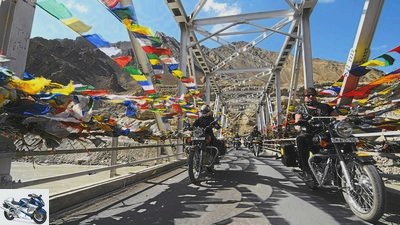
Photo: Lohse
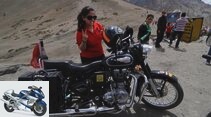


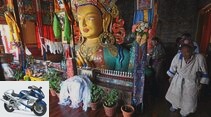
32 pictures
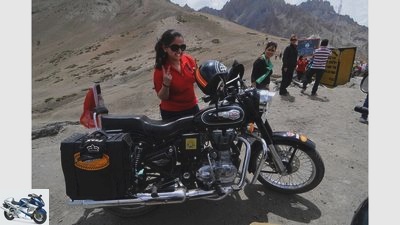
Lohse
1/32
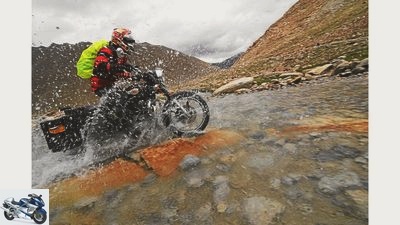
Lohse
2/32
… must not rely on perfect conditions. But a lot can be mastered on the Enfield.

Lohse
3/32
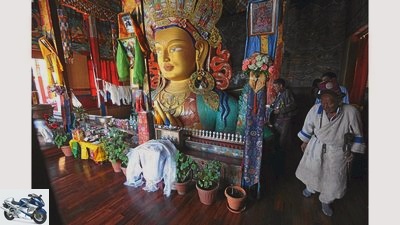
Lohse
4/32
Left-hand traffic, around the left. A rule that applies not only on the street but also in holy places like Thiksey Monastery.
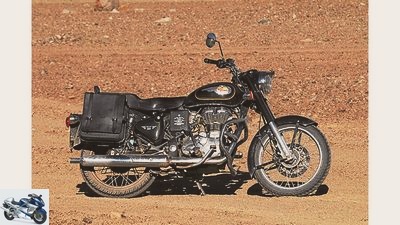
Lohse
5/32
The motorcycle on the tour: Whether it is bad gravel tracks or slippery waterways: the Royal Enfield Bullet 500, made in India, makes its way through the Himalayas with almost stoic persistence.
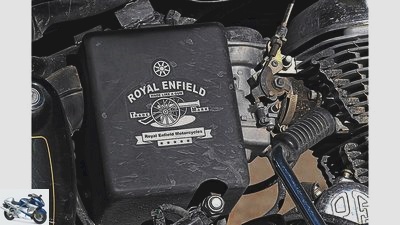
Lohse
6/32
With a consumption of 3.5 liters per 100 km, the Bullet also impresses with a range of almost 400 kilometers.
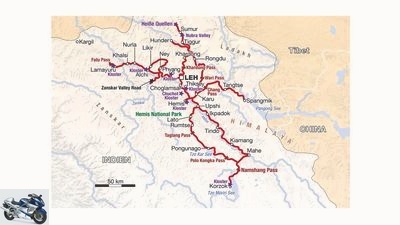
Lohse
7/32
Travel time: 12 days, distance covered: 1800 kilometers.
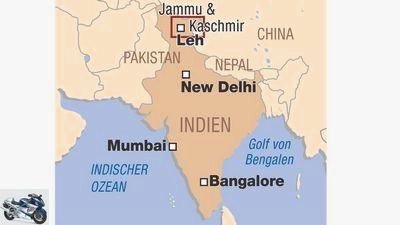
Lohse
8/32
India; Capital: New Delhi; Area: 3,287,469 km²; Independence: 1947; Currency: Indian rupee; Population: 1.21 billion.
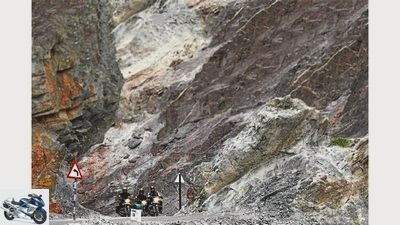
Lohse
9/32
Brittle world. The slate stones in the Zanskar Valley prove it: the mountain does move.

Lohse
10/32
Peter Paulo Dos Santos (55), head of Classic Bike Adventure (www.classic-bike-india.com), has been offering guided motorcycle expeditions through Ladakh for exactly 20 years.
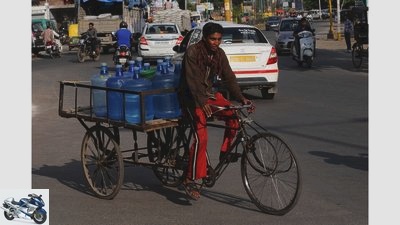
Lohse
11/32

Lohse
12/32

Lohse
13/32
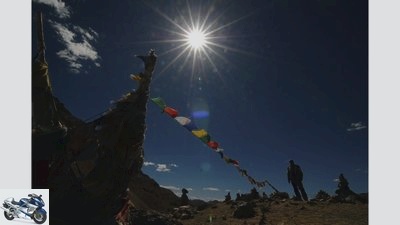
Lohse
14/32
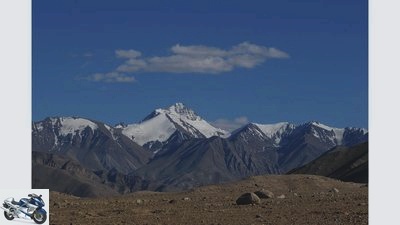
Lohse
15/32
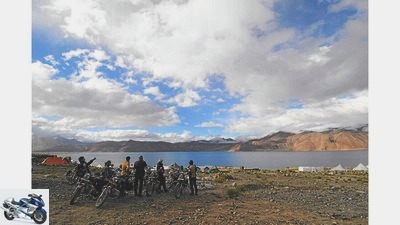
Lohse
16/32
Anyone who wants to set off to such mysterious places as Pangong Lake at 4250 meters …
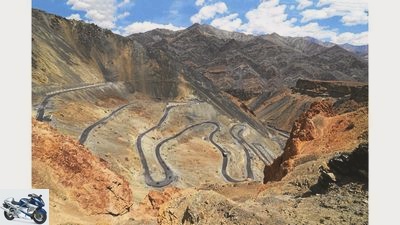
Lohse
17/32
… In Ladakh the word highway is translated very literally. Even the main connection to Srinagar is anything but a highway.
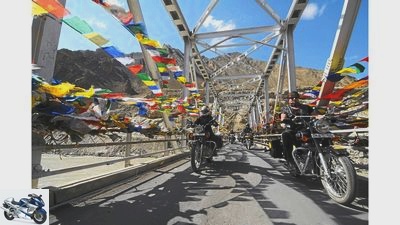
Lohse
18/32
A motorcycle adventure of a very special kind – driving in the Himalayas.
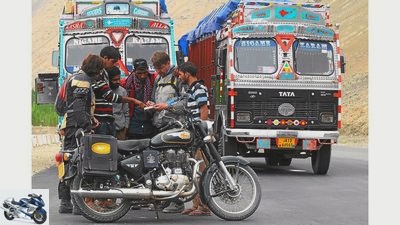
Lohse
19/32
Living on the street. The truck drivers from Kashmir fight their way over the highest passes in the world in smoking tatas …
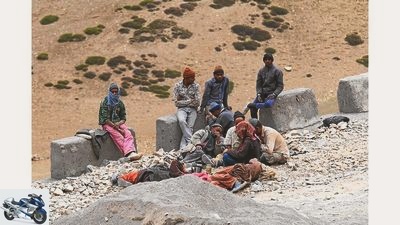
Lohse
20/32
… Whole families from Bihar have to ensure that road damage is repaired.
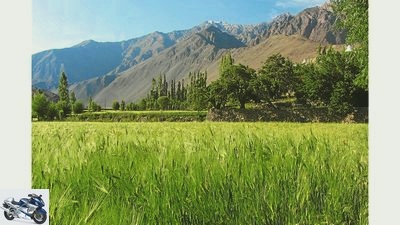
Lohse
21/32
Has shaped the life of the Ladakhis for centuries: agriculture at 3500 meters, …
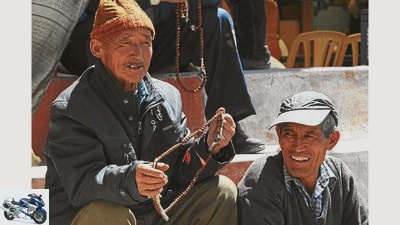
Lohse
22/32
… Buddhist piety.
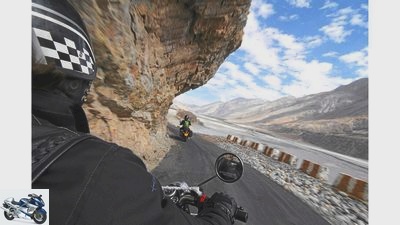
Lohse
23/32
In the saddle the air tastes a bit thicker again.

Lohse
24/32

Lohse
25/32
Om mani padme hum. For the mountain people in the Himalayas, the Buddha’s teaching is in the monasteries of the country …
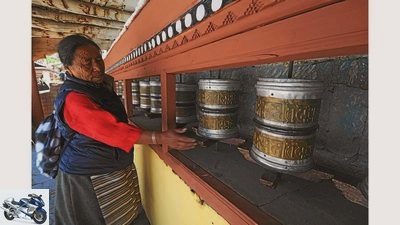
Lohse
26/32
… or omnipresent when reaching for the prayer wheel.
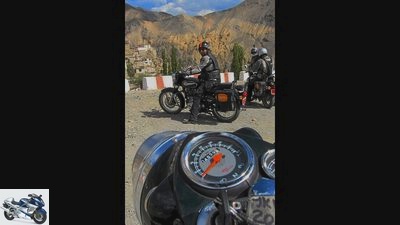
Lohse
27/32
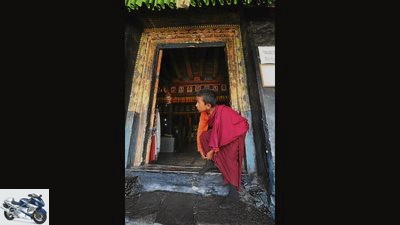
Lohse
28/32
The training of monks begins in childhood.
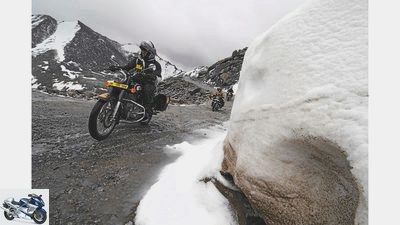
Lohse
29/32
Motorbike tourists, on the other hand, only stammer their prayers on hairy pass descents with a change in the weather (Khardung La Pass).
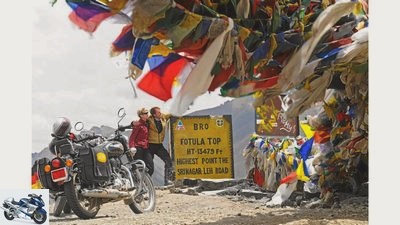
Lohse
30/32
Flags disintegrate on peaks in wind and weather.
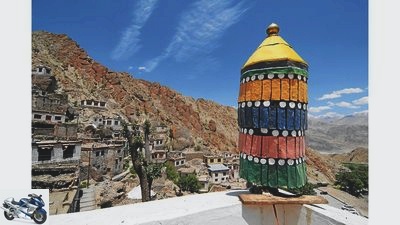
Lohse
31/32
Elevated road …
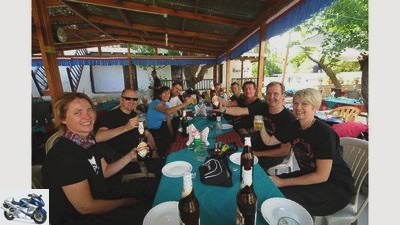
Lohse
32/32
to travel
Motorcycle tour Himalaya Ladakh
Motorcycle tour Himalaya Ladakh
Man and machine at the limit
The roads in the Himalayas are particularly close to heaven. But in the barren loneliness of the huge mountain deserts of Ladakh in northern India you will quickly be grounded again. A motorcycle tour in the border area between man and machine.
Jorg Lohse
09/25/2014
When Leh sinks into darkness, they crawl out of their holes and rob you of sleep. There must be hundreds, if not thousands, of street dogs that set the tone night after night in the capital of India’s Ladakh region. Only when the muezzin calls the Muslim minority to prayer over the loudspeaker in the middle of the night does the yowling, yapping and whining give way for a moment to devout silence. Those who still manage to make a quick prayer of thanks to Aurangzeb. The Indian Mughal ordered the construction of a mosque in this actually Buddhist region in the 17th century. And finally you fall into a restful sleep. This is indispensable because the next morning you have to concentrate fully in order to escape the hustle and bustle of the city unscathed.
Buy complete article
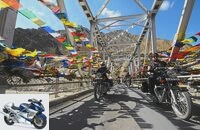
Motorcycle tour Himalaya Ladakh
Man and machine at the limit
10 pages) as PDF
€ 2.00
Buy now
Officially Leh does not have 30,000 inhabitants, but in the summer months tourist crowds seem to have at least doubled the population. And everyone wrangles around this valuable clientele: inconsiderate taxi and minibus drivers, pushy souvenir dealers from Kashmir, friendly, smiling innkeepers. In between, free-roaming cows, darkly smoking Tata trucks and wildly honking motorists push their way through the streets. And those who have recently arrived in Leh as continental Europeans are also struggling with the thin air at 3500 meters and the side effects of aspirin, which is supposed to alleviate the altitude headache a little. Only the dogs don’t bother – they are now lying exhausted in shady corners.
In the saddle, the air tastes a bit thicker again
The deep roar of the Royal Enfield manages to give this chaos a calming frequency. The single cylinder thunders confidently through the colorful maze of alleys. The exertions of the night are forgotten, and the air tastes a bit thicker again in the saddle of the 500. Huge military installations pass by on the outskirts of Leh. In its northernmost state, Jammu and Kashmir, India has to arm itself: Some areas in the north have been occupied by China since 1962. In the west of the divided region of Kashmir, the conflict with neighboring Pakistan is still simmering, from where separatist efforts of violent Kashmiris are supported. Terrorist actions are always part of everyday life. Around 30,000 soldiers are therefore said to be stationed in the numerous military camps and barracks in this region.
On the signpost of the National Highway NH-1D, Srinagar, the capital of Kashmir, is a calming 400 kilometers away. So there is enough spatial distance to safely soak up the mountains of Ladakh. The Bullet 500 gains height in gentle loops. Already a few kilometers after Leh, the driver is captured by loneliness. You look back in disbelief. The wild confusion can still be seen, but the noise of the city can no longer be heard. On the southern edge of Leh, the Indus, surrounded by lush greenery, eats its way through the valley.
When you hear the Himalayas, you usually think of majestic, snow-covered 8000 meter peaks and imagine a landscape like the Alps and Pyrenees stacked on top of each other in XXL format. But in Ladakh the largest mountain range in the world initially presents itself as a gigantic mountain desert with broadly washed river valleys, rugged canyons and sandy plateaus.
Two-wheeler pilots are at the bottom of the street hierarchy
When the Enfield’s engine is off, there is an unreal silence. The asphalt glitters black and disappears into the endlessness of a huge plateau. The air shimmers at 30 degrees. The sun is burning, there are no trees to provide shade. It’s good that the Enfield can rely on the natural air conditioning. The speedometer levels off at 80, much faster, insiders advise, should you not be on the road even on the better-developed roads. Because in the street hierarchy, two-wheeler pilots are at the bottom. Military columns and truckers in their colorful boxes are considered particularly ruthless – despite the pious sayings painted on them or the photo of the Dalai Lama smiling mildly from the roof of the car. In an emergency, bikers have to go into the ditch and hope that it won’t be followed by a deep slope.
The road to Srinagar is peppered with military bases, in the villages right next to it the road movie is running in slow motion. The residents sit lazily in small cafes or snack bars on the roadside and watch the traffic that occasionally flows past, rushing through the village – without really taking off the gas – and shooing stray dogs or an idiosyncratic cow off the street with rhythmic horns. A bus that is packed full to the roof and runs aground with flat tires attracts more attention. A cluster quickly formed around the driver to accompany his daring jack-up action with appropriate comments.
The original flair of Ladakh, as it has been cut off from the outside world for centuries, can still be felt in the valleys that branch off to the left and right of the national highway. Again and again the Enfield chugs through villages that have formed around a Buddhist monastery, or small farming settlements, which are characterized by whitewashed mud houses. The prayer flags in the five holy colors red, blue, yellow, green and white flutter on the flat roofs. Thread by thread, the sacred verses, so-called mantras, dissolve together with the image of the wind horse and scatter their pious messages into the world. Under the colorful flags, the fuel supplies for the winter are already drying in the hot summer sun: straw, brushwood, dung. Strangers are greeted with a happy “Julley, Julley”: “Welcome!”
Even from a distance one could see the efficient use of the landscape around the village. The mountain stream donates the vital water, which is channeled to terraced cultivation areas via a clever sewer system. The houses themselves stand on the rocky, barren subsoil. To sacrifice the green land for this is unthinkable for traditionally thinking Ladakhis. After all, the short summer period must be sufficient to bring in the richest possible harvest of barley, potatoes or beets on the sparse arable land. The ripening period is short but intense. The interplay of dry heat and a skilful supply of water causes the plants to literally explode in just under four months. So also the apricots, a national fruit of the Ladakhis.

to travel
On the way: India
On Royal Enfields through South India
read more
It is unimaginable how roads are built here
At this moment it is inconceivable that Ladakh would freeze in the freezing cold for months. In the middle of winter, the thermometer drops to well below minus 30 degrees at night, and even during the day the freezing point is rarely exceeded. Motorcyclists also get a faint inkling of this in midsummer, when the weather suddenly changes on the way up to the highest passable pass in the world, the Khardung La at 5360 meters, and the scorching heat in the valley is followed by heavy snow and sleet showers. Now you not only have to struggle with the icy road, which on the last 20 kilometers to the top of the pass looks more like a narrow, rocky beaten path and, to make matters worse, is clogged by two military columns meeting each other.
But the clammy cold in your own fingers is quickly forgotten when you see the conditions under which roads are being built and maintained in this strategically important region on the descent. The Border Roads Organization, a road construction authority of the Indian military, is responsible. Just below the top of the pass, a few dozen workers at 5000 meters above sea level are busy smashing boulders with the simplest of equipment or pouring baskets and cloths into earth.
The longer you are in Ladakh, the more often the picture will repeat itself. Usually it is whole families from Bihar, one of the poorest regions of India, who at some point, out of sheer need, pledged their working life to moneylenders and were finally “sold on” to the military road construction command. This may seem strange to European travelers. For Lokesh from Solan in the state of Himachal Pradesh, the work columns are a completely normal sight.
Unmoved, he rushes through the construction site on his rented Yamaha with pressure on the horn. The 29-year-old engineer spends his short summer vacation in Ladakh, and the 14 days have to be filled as profitably as possible: motorcycling, white water rafting on the Zanskar, party in Leh in the evening. According to Western understanding, it is difficult to grasp that he sits on a motorcycle while his peers have to break stones all their working life. At best, it can be explained by the caste system that has shaped Indian society for thousands of years.
On this tour the extremes come up again and again. For centuries, the rural Ladakhis have found their own rhythm of life in the seclusion of the mountains, characterized by harmony with nature and profound religiosity. But with the modern age, which has shaken the country almost explosively in the last few decades, the Ladakhis are now faced with enormous tasks in order to preserve the beauty and mightiness of their living space.
The Enfield hums past the monastery of Likir, winds its way through a landscape of gigantic rock faces at 4100 meters to the Hemis Supachen. At the top of the pass, prayer flags shredded in the wind. There is silence for hours, in the afternoon a shepherd crosses the hill with his donkey herd. And suddenly you feel very close to heaven again.
Royal Enfield Bullet 500
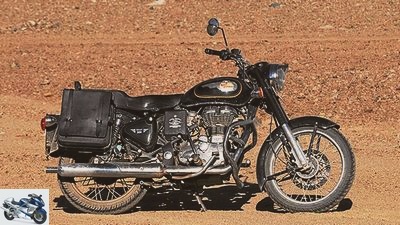
Lohse
Air-cooled single-cylinder four-stroke engine, 499 cm³, 19 kW (26 PS) at 5100 rpm.
Whether it is bad gravel slopes or slippery waterways: the Indian-made Royal Enfield Bullet 500 makes its way through the Himalayas with almost stoic persistence. And with her good-natured manner, she never overwhelms the driver, who can either concentrate fully on the traffic and road conditions or just want to enjoy the fantastic panorama.
With the appropriate carburetor adjustment, the motorcycle, which was originally designed for the military, poses no problems even above 5000 meters. With a consumption of 3.5 liters per 100 km, the Bullet also impresses with a range of almost 400 kilometers.
Information about the trip
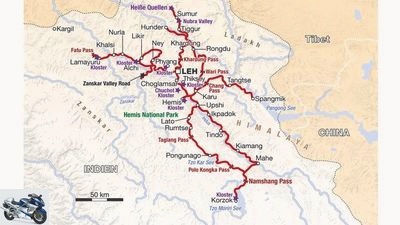
Lohse
Duration of the trip: 12 days; Distance covered: 1800 kilometers.
On a motorcycle to the highest passes in the world – a feast for the senses. But India’s north offers even more: a journey through time through the centuries-old traditions of the Ladakhis.
Generally: Ladakh is an autonomous region in the Indian state of Jammu and Kashmir. The largest city is Leh, in which around ten percent of the 270,000 inhabitants live. The size of Ladakh is roughly twice the area of the state of Lower Saxony. Today’s Ladakh is based on an ancient Buddhist kingdom that has belonged to India since 1834. Today more parts of the original area belong to China and Pakistan. India’s conflicts with these two neighboring states lead to a strong military presence in Jammu and Kashmir. It is estimated that around 30,000 soldiers are stationed in this region.
Traffic: In Ladakh, as in all of India, there is left-hand traffic. Motorcyclists should be prepared for a defensive driving style. To be taken particularly seriously: the note “Blow horn” (please honk) on the tailgate of the truck. Only when the driver gives signals should the vehicle be overtaken. The road conditions are very mixed, even on the main connecting roads. Kilometers of gravel passages are more the rule than the exception. There are also dangers from numerous obstacles on almost all roads (broken rocks, potholes, animals on the road). Some passes (including the Khardung La) can only be reached via scree slopes, and larger water crossings are not uncommon, which is why Ladakh travelers should bring some off-road experience with them or have completed enduro training. Certain areas are considered restricted zones and can only be entered after prior notification at checkpoints (“Police Check Post”). The passport with India visa and an international driver’s license should therefore always be at hand.
Health: The capital Leh is 3500 meters above sea level, many passes at over 5000 meters. The oxygen-poor mountain air is particularly difficult for many travelers in the first week. Aspirin can help. Other problems can arise when eating and drinking, which is why a quick-acting diarrhea drug (e.g. Imodium Akut) should be included in the first-aid kit. Tip: As a preventive measure, start taking yeast tablets (e.g. perenterol) five days before departure. In general, you should eat and drink with care: well-cooked food, no raw vegetables / salad, water only from sealed bottles – even when brushing your teeth.
Sightseeing features: A detailed tour of the city is a must in Leh. A footpath leads from the old town to the old royal palace (which now houses a museum) and on to the monastery, from which a fantastic view over the city and the Indus valley compensates for the exertion of the steep climb. The Shanti stupa is well worth seeing on another mountain. An insider tip is the Sankar monastery, located a little outside the center. How the Tibetan Buddhist culture has shaped Ladakh over the centuries can also be experienced by visiting the monasteries of Alchi, Hemis and Thiksey.
Souvenirs: If you want to buy your souvenirs a little more consciously, visit the shop of the self-initiative Ladakhi country women in Leh (Main Street, www.ladakhnatureproducts.com) or the Open Hand Cafe (Library Road, www.openhand.in).
Organized trips: The described tour of Classic Bike Adventure is offered by the MOTORRAD action team. Dates and prices in the catalog section of this edition (reversible booklet) on page 13.
Maps / literature:Ladakh and Zanskar Trekking Map, (14 euros). To prepare for your trip: Helena Norberg-Hodge; to live in
Ladakh, (antiquarian, e.g. Amazon).
Interview with Peter Paulo Dos Santos

Lohse
Peter Paulo Dos Santos (55).
“Stay an Adventure”
For exactly 20 years, Peter Paulo Dos Santos (55), head of Classic Bike Adventure (www.classic-bike-india.com), guided motorcycle expeditions through Ladakh. The native of the Sauerland had already started tours in Goa five years earlier. Prominent passenger on his first Goa trip: rock singer Farin Urlaub from the band “Die arzte”.
In 1994 Ladakh was still a no man’s land in terms of tourism. What has changed the most on your tours??
When we started up here 20 years ago, there was practically nothing: no infrastructure, hardly any information. In the first few years, our Ladakh tours were real adventure trips with an expedition character. We had to take all kinds of equipment with us and couldn’t rely on anything. The slopes had only just been opened for civil traffic, previously only the military were allowed to travel here. Which is why you couldn’t fall back on any empirical values. The journey alone was tough: 800 kilometers from Manali – without asphalt! Today you get on the plane in Delhi and just under two hours later you are at the airport in Leh.
And what is left?
Of course, a lot has been simplified and made safer. But our tour through Ladakh is and remains an adventure. Finally we drive our Enfields through the highest mountains in the world.
What are your personal top spots in Ladakh?
The Tzo Moriri lake and the salt lake Tzo Kar at over 4500 meters. The view is always fantastic and the encounter with the nomads is very moving.
Related articles
-
Schulz to travel Motorcycle world tour Motorcycle world tour 50,000 kilometers home Many dream of the great journey, the trip of a lifetime. At some…
-
Motorcycle tour Altiplano Chile and Bolivia
Biebricher, Werel 23 pictures Biebricher, Werel 1/23 The plateau is more than 3300 meters above sea level. This is not only felt by the human body, but…
-
Motorcycle tour through Bolivia
Daniel Lengwenus 29 pictures Lengwenus 1/29 Experienced globetrotter takes on a young student for her first tour of South America. An adventure in itself…
-
Motorcycle tour through Algeria
to travel Motorcycle tour through Algeria Motorcycle tour through Algeria The dunes of the Sahara Algeria. The grave road, the sand dunes from Erg…
-
Motorcycle tour Baja California and California
Jo Deleker 35 pictures Jo Deleker 1/35 Jo Deleker 2/35 The man and the sea: the sun rises at seven in the morning from the Gulf of California near Bahia…
-
Dentges 40 pictures Dentges 1/40 Failing on an 8000 is no shame. But not to pack Mount Fuji, which is barely half as high in Japan? That is weak. Dentges…
-
Breakable 22nd pictures Breakable 1/22 Island happiness: The slender streets of the Isle of Mull enchant especially around the highest mountain Ben More…
-
Motorcycle tour – the north of Chile
Markus Biebricher 14th pictures Markus Biebricher 1/14 Communicative: break at the trucker bar in the middle of nowhere Markus Biebricher 2/14 Evening…
-
Motorcycle tour through Guatemala and Belize
Jo Deleker 30th pictures Jo Deleker 1/30 Impressions from Jo Deleker’s motorcycle tour through Guatemala and Belize. Jo Deleker 2/30 Healthy “Fast food”…
-
Motorcycle tour Andes Northern Argentina Chile
Lengwenus 47 pictures Lengwenus 1/47 The pictures for the report “Motorcycle trip across the Andes – Northern Argentina and Chile”. Lengwenus 2/47 The…